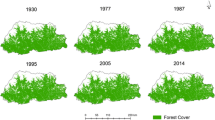Abstract
This paper analyzed forest land use change in Trans-Boundary Laos-China Biodiversity Conservation Area which is called Namha National Biodiversity Conservation Areas (Namha NBCAs), with 1992 and 2002 TM (ETM). Based on GIS and statistical methods, the intensity, state index of land use change and transfer matrix were used to study spatiotemporal land use change in the region. The results showed that the area of forest land decreased greatly, also the area of bamboo and grassland decreased. The other way round, the area of unstocked forest, slash and burn and rice paddy land increased. As a whole, the intensity of forest land change was higher, but others were lower. From the transfer matrix, most of the forest land changed into unstocked forest and urban area, some to slash and burn. The grassland and bamboo were mainly transferred to forest and unstocked forest. The unstocked forest land mostly came from forest land and grassland. It was showed there were three main causes of the land use change namely: opium poppy cultivation, rubber plantation and also ecotourism activities and finally some policies were developed in order to address the land use change in the study areas.
Similar content being viewed by others
References
Chen B M, Liu X W, Yang H, 2003. Review of most recent progresses of study on land use and land cover change. Progress in Geography, 22: 22–29. (in Chinese)
Chen X L, Zhao H M, Li P X et al., 2006. Remote sensing image-based analysis of the relationship between urban heat island and land use/cover changes. Remote Sensing of Environment, 104: 133–146.
Ding H, Wang R C, Wu J P et al., 2007. Quantifying land use change in Zhejiang coastal region, China using multi-temporal landsat TM/ETM+ images. Pedosphere, 17: 712–720.
Government of the Lao PDR (GoL). 1996. National Forestry Law No. 01-96. Ministry of Agriculture and Forestry. Vientiane.
GoL, 2003. National Biodiversity Conservation Area Decree 164. Prime Minister’s Office. Vientiane.
Lambin E F, Turner B L, Geist H J et al., 2001. The causes of land-use and land-cover change: Moving beyond the myths. Global Environmental Change, 11: 261–269.
Lee C L, Huang S L, Chan S L, 2008. Biophysical and system approaches for simulating land-use change. Landscape and Urban Planning, 86: 187–203.
Liu Y S, Chen B M, 2002. The study framework of land use/cover change based on sustainable development in China. Geographical Research, 21: 324–330. (in Chinese)
LNTA, 2005a. Annual Statistics Report. Lao National Tourism Administration. Vientiane.
LNTA, 2005b. Mekong Tourism Development Project, Part B, Pro-Poor Community-Based Tourism Component. Annual report: Provincial, village and household monitoring data. Lao National Tourism Administration. Vientiane.
Munroe D K, Müller D, 2007. Issues in spatially explicit statistical land-use/cover change (LUCC) models: Examples from western Honduras and the Central Highlands of Vietnam. Land Use Policy, 24: 521–530.
Nam Ha NPA Management Unit and WCS Lao Programme, 2004. Nam Ha National Protected Area 2003-2010 Management Plan (draft version 6b). Wildlife Conservation Society Lao Programme. Vientiane.
Pontius Jr. R G, Schneider L C, 2001. Land-cover change model validation by an ROC method for the Ipswich watershed, Massachusetts, USA. Agriculture, Ecosystems and Environment, 85: 239–248.
Shi L Y, Lu X, Cui S H, 2008. Research progress on ecological effects of land change. China Land Science, 22: 73–79. (in Chinese)
Tian Y M, Li X, 2006. Review of researches on environmental effects of land use/cover change. Environmental Science and Management, 31: 60–64. (in Chinese)
Tizard R, 1997. A Wildlife and Habitat Survey of Nam Ha and Nam Kong Protected Areas, Luang Namtha Province, Lao PDR. CPAWM-WCS Cooperative Programme: Department of Forestry, MAF. Vientiane.
United Nations Office for Drug Control and Crime Prevention, 2002. Laos’s Opium Survey 2002: Laos. Vienna: United Nations.
United Nations Office for Drug Control and Crime Prevention, 2003. Laos’s Opium Survey 2003: Laos. Vienna: United Nations.
United Nations Office for Drug Control and Crime Prevention, 2004. Laos’s Opium Survey 2004: Laos. Vienna: United Nations.
United Nations Office for Drug Control and Crime Prevention, 2005. Laos’s Opium Survey 2005: Laos. Vienna: United Nations.
United Nations Office for Drug Control and Crime Prevention, 2006. Opium Poppy Cultivation in the Golden Triangle 2006. Vienna: United Nations.
Veldkamp A, Lambin E F, 2001. Predicting land-use change. Agriculture, Ecosystems and Environment, 85: 1–6.
Wu H A, Jiang J J, Zhang H L et al., 2006. Urban expansion and its effects on eco-environment in Xi’an region based on Landsat TM data. Journal of Natural Resources, 21: 311–318. (in Chinese)
Zhang X M, Yu X X, Wu S H et al., 2007. Response of land use/coverage change to hydrological dynamics at watershed scale in the Loess Plateau of China. Acta Ecologica Sinica, 27: 414–423.
Zhu J, 2006. The changes of land use in Baotou City for recent ten years. Yinshan Academic Journal, 3: 17–22.
Author information
Authors and Affiliations
Corresponding author
Additional information
Author: HEMMAVANH Chanhda (1970–), male, Ph.D, Vientiane Capital, Laos, specialized in forest land use planning.
Rights and permissions
About this article
Cite this article
Hemmavanh, C., Ye, Y. & Yoshida, A. Forest land use change at Trans-Boundary Laos-China Biodiversity Conservation Area. J. Geogr. Sci. 20, 889–898 (2010). https://doi.org/10.1007/s11442-010-0818-1
Received:
Accepted:
Published:
Issue Date:
DOI: https://doi.org/10.1007/s11442-010-0818-1




